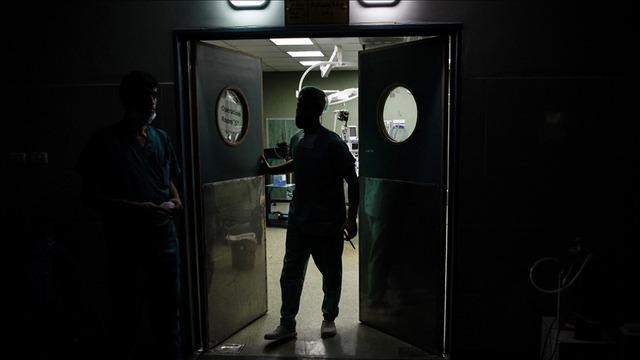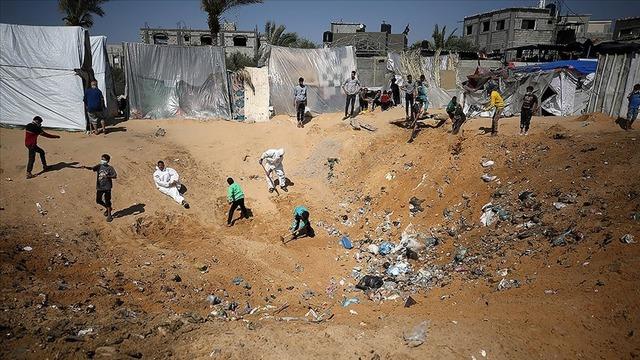Skin infections and hepatitis are spreading as Gazans under Israeli attack begin drinking and bathing in contaminated water.
Doctors told 7-month-old Sobhia’s mother that the raised rash on her skin was caused by bacteria in the contaminated water, according to NBC News. Born a few months after the start of the Israel-Hamas war, the baby is one of many young children in Gaza who have contracted illnesses related to drinking or bathing in contaminated water, according to families, doctors and humanitarian groups in the area. Common problems include hepatitis and skin infections.
“WE COULDN’T FIND WATER TO WASH OUR CHILDREN”
Sobhia’s mother, Samar Hamoda, said in an interview last month that the family had been forced to flee northern Gaza and were stuck in an evacuation zone in the southern city of Khan Younis. (The Israeli army ordered an evacuation in eastern Khan Younis on Friday.) “We came here in even worse conditions,” Hamoda said. “We had no clean place to stay and no drinkable water to wash our children with,” she said. She added that Sobhia had been prescribed medication but her family had not been able to find a hospital or clinic that would give them to them for free and she could not afford them.
A LARGE PART OF THE INFRASTRUCTURE HAS BEEN DESTROYED
Gaza’s water system relies heavily on wells and desalination plants, but much of that infrastructure has been destroyed. Aid group Oxfam International estimated last month that 88 percent of all Gaza’s desalination plants and water wells had been destroyed or damaged.

THE AMOUNT OF USABLE WATER IS UNDER 5 LITRES PER PERSON PER DAY
According to Oxfam, 70 percent of all Gaza’s wastewater treatment plants and sewage pumps are also gone. As a result, the amount of water available in Gaza has fallen by 94 percent since the war began, the group estimates, to less than 5 liters per person per day. (The United Nations says people need at least 15 liters per day in emergencies.)
Israeli authorities did not respond to a request for comment on the illnesses caused by contaminated water in Gaza. But the Israeli government body that liaises between aid agencies and the military – the Coordination of Government Activities in the Territories, or COGAT – said last month that it had set up a team in X to address sanitation issues in the area, including cleaning up waste and providing power for a desalination plant. “The team is also exploring additional measures to improve sanitation in Gaza, such as repairing wells, improving desalination facilities and extending water lines,” COGAT said.

Humanitarian groups have also tried to repair infrastructure, install septic tanks and distribute clean water and chlorine tablets, but their access to the area is extremely limited, forcing residents to drink and bathe in untreated seawater contaminated with sewage without soap or disinfectant.
“You don’t have significant amounts of safe, potable water coming across the border in tankers, your desalination efforts aren’t working, and your wastewater treatment systems that would keep fecal pollution down aren’t working,” said Steve Morrison, senior vice president of the Center for Strategic and International Studies, a nonprofit think tank.
Consuming food or water contaminated with feces can lead to Hepatitis A, a liver disease that can resolve on its own, but poor nutrition and sanitation can increase the risk of complications.

“HEPATITIS A IS COMMON IN THE GAZA STRIP”
“Hepatitis A is prevalent in the Gaza Strip today due to poor sanitation, poor food quality and pollution of water,” Dr. Ahmed Al-Farra, head of the pediatric department at Nasser Hospital in Khan Younis, said in June.
He described a 4-year-old boy in hospital who was suffering from liver failure due to Hepatitis A. Al-Farra said the boy’s condition required a transplant, which “was not available in the Gaza Strip even before the war.”
NUMBER OF CASES INCREASED FROM 85 TO 40 THOUSAND
The United Nations estimates that there have been around 40,000 cases of hepatitis A in Gaza since the war began, compared to just 85 from October 2022 to July 2023. This is in addition to more than 1 million new acute respiratory infections, more than half a million cases of acute diarrhoea, and more than 100,000 cases of jaundice. From October to the end of June, the World Health Organization also recorded around 65,000 cases of skin rashes and more than 103,000 cases of scabies and lice.
Khan Younis Mayor Alaa al-Bata said at least 30 water wells had been destroyed in southern Gaza in the past month. “Most of the other wells are in evacuation areas and we fear they will be destroyed,” he said. “We are experiencing a serious water crisis,” he added.

“WHEN I’M THIRSTY I DRINK SALT WATER”
Nasrin Al-Qarra, who was displaced with her family and has been living in Khan Younis since last week, described long queues for bath water. “We drink salt water very often,” she added. “We don’t think about what will happen to you later. The important thing is to drink when I’m thirsty, that’s all,” she said.
The United Nations said work was underway to restore power to a desalination plant in southern Gaza, which could provide clean water to about a million people.
WHO: RISK OF POLIO SPREADING IS HIGH
But in the meantime, health threats related to contaminated water continue to grow: Poliovirus was detected in six wastewater samples in Gaza in June, after polio vaccination rates dropped in the region last year. No new cases have been confirmed, but WHO says the risk of polio spreading in Gaza is high. The virus can spread through a number of means, including drinking water contaminated with the feces of an infected person.
WHO plans to distribute 1.2 million polio vaccines in Gaza in the coming weeks. The Israeli military did not respond to a request for comment on the polio risk in the area, but COGAT said on Tuesday that it was supporting a polio vaccination campaign in X and was in contact with WHO and UNICEF about the situation. (The Israeli military also said it would offer polio vaccines to its soldiers in Gaza.)
CHALLENGES OF VACCINATION STUDIES
But Morrison said the vaccination drive faces major challenges: doses must be kept cold to prevent spoilage and it is unclear whether there are enough health workers to administer them.
“We know that the best way to vaccinate children multiple times is to do it in their homes. But here, people are not in their homes,” he said.
